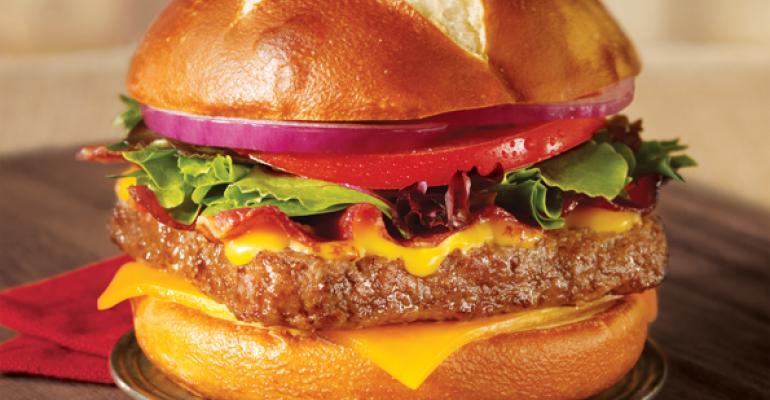The Wendy’s Co. said its “Pretzel Love Songs” social media campaign was a success second only to its iconic “Where’s the Beef?” ads from 30 years ago, which may provoke the same level of skepticism shown by Clara Peller in those commercials. However, the latest numbers support the claim.
According to a report from Wendy’s and Facebook, the four humorous videos that promoted the chain’s successful limited-time offer Pretzel Bacon Cheeseburger reached 85 million people — meaning viewers, not just total views. Seventy-five percent of those impressions came on Facebook’s mobile platform during the campaign’s five-week run last July and August.
Wendy’s officials conceded that the videos for “Pretzel Love Songs” had a high production value and featured a high-profile personality in singer Nick Lachey, but said the true key to the campaign’s success is that it sprang from current social media trends, including the dominance of mobile over desktop, the popularity of video, and a brand voice that is far more conversational than it is promotional.
MULTIMEDIA
Watch Nick Lachey croon tweets about the Pretzel Bacon Cheeseburger
RELATED
• Wendy's 2013 profit soars on refranchising benefit
• Wendy's introduces Ciabatta Bacon Cheeseburger
• More restaurant marketing news
“It can’t just be about, ‘how much money do I have to spend to break through,’” said Brandon Rhoten, Wendy’s vice president of digital and social media. “It’s about the content, and it has to fit the environment contextually. The test of a good ad is: do you want to see it again? That’s more true than ever on a network like Facebook, where you can click that X on the ad and never see that brand’s content ever again.”
‘I Love the ’90s’
Wendy’s “Pretzel Love Songs” featured several videos around a musician singing cheesy pop songs with a distinctly “MTV in the ’90s” feel, using lyrics taken verbatim from tweets and Facebook posts of people gushing about how much they loved the Pretzel Bacon Cheeseburger when they encountered it in a test market. The campaign built to a climax of Nick Lachey, lead singer of ’90s boy band 98 Degrees, starring in the final video and making several public appearances for Wendy’s.
Wendy’s took a similar tack with subsequent Facebook campaigns, including “Pretzel Love Stories” for the Pretzel Pub Chicken sandwich in October 2013, and a parody of British theater last November to promote the Bacon Portabella Melt. In each case, Rhoten said, the videos worked because they were the kind of humorous content guests expect, or at least don’t mind, in their Facebook feeds.
“The primary reason why we grow is because we talk like a friend would,” Rhoten said. “We don’t speak like a 15-second TV spot, because those are interruptive and don’t fit the environment they’re in. When we make a goofy video about love for a cheeseburger, that’s the kind of content your friends send to you if they’re the ones sending you ‘What Does the Fox Say?’”
Wendy’s was the first restaurant brand to develop a campaign with Facebook through the social network’s Publishing Garage, a boot-camp-style idea-generation session involving the brand, its agency partners and Facebook.
Ben Nemo, Facebook’s business lead for the restaurant vertical and a former marketing executive with Burger King, said Wendy’s achieved its breakthrough with the campaign for Pretzel Bacon Cheeseburger because it understood the value of “frequent, lightweight conversations” with fans that laid the groundwork for people to expect content that was engaging, not just sporadic and solely promotional.
“Back in 2012, you probably saw a lot of what you’d see in a restaurant on Facebook,” Nemo said. “You might have seen something that looked like a table tent. You’re not expecting to see table tents from your friends. … That kind of everyday conversation buys you the trust, so when you want to go sell a new Pretzel Bacon Cheeseburger and tell the world about it, you get the reaction.”
No longer the 'second screen'
Rhoten said Wendy’s achieved a large incremental audience that normally does not tune in to its TV commercials, citing data from Facebook and Nielsen that found 62 percent of those new viewers were Millennials between ages 18 and 34. He and Nemo agreed that Wendy’s success in creating mass awareness for the campaign, especially among younger consumers, resulted from the mobile focus.
“We use digital and social media as a conduit to connect to people a bit younger, but those people don’t live in a bubble,” Rhoten said. “You still watch TV, just not what your parents watch, and you’ve probably got your smartphone in your lap.”
Restaurants are interested in mobile-only campaigns “because it’s as close to the purchase decision a brand can get,” Nemo said. Facebook shared in its most recent earnings call that its base of daily active users on its mobile platform averaged 556 million people in December 2013, a 49-percent increase from a year earlier, and Facebook users check the app an average of 14 times per day.
Wendy’s wanted to optimize its campaign for mobile because the Facebook app’s main screen contains only the newsfeed, which has higher levels of sharing and recall than the right rail of Facebook’s desktop version.
“It’s a full-screen takeover,” Nemo said. “If [an ad] catches your attention, you stop your ‘rule of thumb’ just tracking through and are more likely to engage with content for a brand.”
Long-term relationship
Rhoten described Wendy’s marketing investment as “a bit more” to produce “Pretzel Love Songs,” but not a significant multiple of normal advertising costs.
“We put serious money behind creative in digital,” he said, “because we know we can reach tens of millions of people if it’s good.”
He added that, while the “Pretzel Love Songs” videos never ran on TV as commercials, they were a boon to Wendy’s public relations team, who leveraged the viral buzz of the videos into appearances on “Good Morning America” and “Mad Money with Jim Cramer.” Combined with the chain’s broadcast advertising, the campaigns supported Wendy’s premium limited-time offers that drove domestic same-store sales increases of 3.2 percent and 3.1 percent in the third and fourth quarters, respectively.
Wendy’s is debating how it might apply future mobile-first campaigns on Facebook to other parts of the business, even perhaps to a core equity like the Frosty or the Baconator, which have their own social media presence apart from Wendy’s profiles.
“People’s attention can be held only so long, so you have to be careful how much you flash shiny things at people,” Rhoten said. “But there’s no reason a Spicy Chicken Sandwich can’t receive the same outpouring of attention. When people talk to us on social media, they like to talk to us about that sandwich or the French fries.”
Nemo added that Facebook tailors its mobile campaigns to allow for cost-effective continual marketing, which could support core menu items or perhaps new dayparts. Brands get a better ability to target certain demographics if they work with more of Facebook’s paid-media programs like sponsored posts, he said.
“We’re certainly a natural fit to go for that massive-awareness play and drive a bunch of traffic for the month, but this could support any ongoing sales initiative,” he said. “No brand would spend 52 weeks on TV to support products people know about. But you could have an ongoing, always-on continuity plan on Facebook for a fraction of the cost of TV.”
Dublin, Ohio-based Wendy’s operates or franchises more than 6,500 restaurants in the United States and 28 foreign markets.
Contact Mark Brandau at [email protected].
Follow him on Twitter: @Mark_from_NRN






